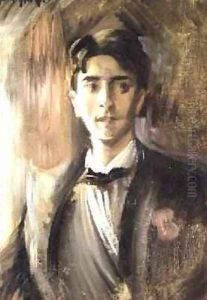Frederico de Madrazo Paintings
Federico de Madrazo y Kuntz was a renowned Spanish painter, born on February 9, 1815, in Rome, Italy, where his father, José de Madrazo y Agudo, also a prominent painter, was serving at the Spanish court. Federico was part of a prestigious artistic lineage; his grandfather was the painter José de Madrazo, and his brothers, Luis de Madrazo and Pedro de Madrazo, were also well-accomplished in the arts. Federico's son, Raimundo de Madrazo, would continue the family tradition, becoming a well-known painter in his own right.
From a young age, Federico de Madrazo showed an exceptional talent for painting. He trained under his father and later attended the Real Academia de Bellas Artes de San Fernando in Madrid. His talent was recognized early on, and he was admitted to the academy at the age of 12. In 1831, he moved to Paris to study under the tutelage of Léon Cogniet, which further refined his technique and introduced him to the French artistic circles.
Madrazo's work is characterized by his skillful portrayal of the human figure, his use of light, and his precise draughtsmanship. He was highly influenced by the neoclassical style but also incorporated romantic elements into his work. Throughout his career, Madrazo painted portraits, historical subjects, and religious scenes. He gained great acclaim for his portraits, which were sought after by the aristocracy and the royal family, including Queen Isabella II of Spain.
In addition to his painting, Federico de Madrazo held several important positions throughout his lifetime, serving as the director of the Museo del Prado in Madrid twice, from 1860 to 1868 and from 1881 to his death in 1894. He was instrumental in modernizing the museum and increasing its collection. His influence extended beyond Spain, as he was an active member of various European academies and received numerous awards and honors for his work.
He died on June 10, 1894, in Madrid, leaving behind a legacy that solidified the Madrazo family's impact on the art world. His works are held in major museums and collections across the world, and he is remembered as one of the most important Spanish painters of the 19th century.
